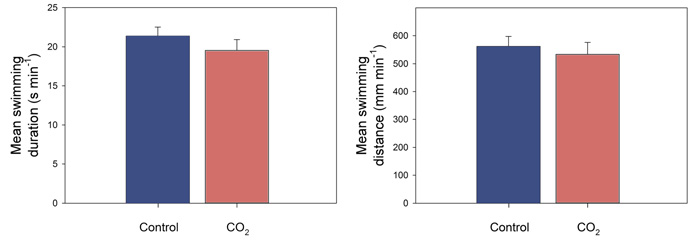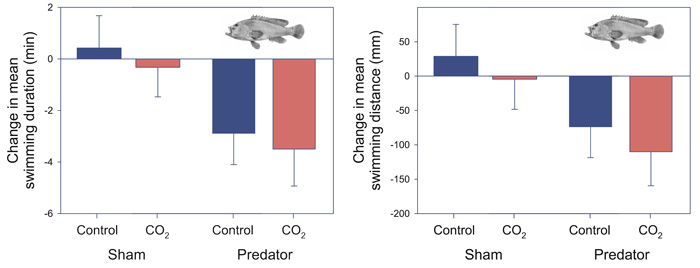| Follow @co2science |
Paper Reviewed
Sundin,J., Amcoff, M., Mateos-González, F., Raby, G.D., Jutfelt, F. and Clark, T.D. 2017. Long-term exposure to elevated carbon dioxide does not alter activity levels of a coral reef fish in response to predator chemical cues. Behavioral Ecology and Sociobiology 71: 108, doi: 10.1007/s00265-017-2337-x.
The fitness of marine organisms is one aspect of the ocean acidification debate that has received a fair amount of attention of late. In this regard, scientists focus on fish behavior, usually the behavioral response of fish to potential predators under normal and reduced seawater pH.
The most recent study to investigate this topic comes from the six-member research team of Sundin et al. (2017), who writing as background for their work, say that "the aspect of fish behavior receiving the most attention with respect to elevated CO2 is the response to chemical cues, such as the alarm cues released from conspecific and/or heterospecifics, or the array of chemical cues emitted from predators." A number of studies, for example, have reported that prey fish exposed to reduced seawater pH are mistakenly attracted to chemical cues from predators rather than being repulsed by them. This seemingly CO2-induced impaired ability to learn to recognize predator chemical cues and then initiate steps to avoid predatory encounters has been a cause for cautionary alarm among ocean acidification alarmists. However, Sundin et al.'s new study raises serious doubts regarding those concerns.
Recognizing that "most studies have exposed the fish to CO2 for very short periods before behavioral testing," on the order of a few hours to weeks, Sundin et al. designed an experiment to test the behavioral response of a coral reef damselfish (the spiny chromis, Acanthochromis polyacanthus) to ocean acidification after nearly three months of elevated CO2 exposure. More specifically, after exposing young juvenile damselfish (age 3-20 days post-hatching) to nearly 3 months of normal (425 µatm) or elevated (1012 µatm) CO2, they assessed their routine activity levels and behavioral responses to chemical cues collected from predatory flagtail groupers. Given previous reports of negative behavioral responses of coral reef fish to elevated CO2, the authors hypothesized that they would detect similar reactions. So did they?
As shown in Figure 1 below, Sundin et al. found no difference between routine activity levels (swimming duration and distance) measured in fish reared under control or elevated CO2 conditions prior to examining their behavioral response to predatory cues. In the behavioral response test, fish subjected to sham (normal, no predator chemical cue) water injections exhibited no statistical change in their swimming duration or distance, regardless of CO2 treatment. In contrast, activity levels decreased in fish receiving the predator cue injection under both CO2 treatments, though the magnitudes of those decreases were not altered by CO2 treatment.
In light of the above findings, Sundin et al. state that their study "contrasts with the majority of reports on coral reef fishes by showing no effect of elevated CO2 on routine activity levels or on the behavioral response to predator cues." Indeed, the fish they exposed to elevated CO2 levels for three months "had a similar routine activity level as control fish reared at present-day CO2 levels, and they decreased their activity level to the same extent as the control fish when exposed to predator chemical cues."
With respect to why their study results turned out so different from those reported by others, Sundin et al. suggest it may be due to the fact that their study was "the first to use automated tracking software to quantify the activity responses of a coral reef fish to predator chemical cues in the context of ocean acidification," which software allows for "more precise data of higher validity and objectivity." They also note that their tracking software "is not subject to observer biases (e.g., confirmation bias, which is the unintentional preference to detect and focus on outcomes that confirm prior beliefs." But perhaps most important of all was the acclimation time allowed in their study (almost 3 months as opposed to days or weeks in other studies) for the fish to be reared in the elevated CO2 conditions prior to testing. Whatever the case, one thing is for sure, as expressed in the final section of their paper: "This study thus adds to the growing literature reporting no behavioral effects in fishes following acclimation to elevated CO2."

Figure 1. Mean (± SE) routine swimming duration (left panel) and swimming distance (right panel) of juvenile spiny chromis (Acanthochromis polyacanthus) after being reared for 3 months in control (425 µatm, blue bars) or high CO2 (1012 ?atm, pink bars) treatments at 23.3 ± 0.27 °C. Adapted from Sundin et al. (2017).

Figure 2. Mean (± SE) change in swimming duration (left panel) and swimming distance (right panel) of juvenile spiny chromis (Acanthochromis polyacanthus) between 30-min pre- and post-injection periods, where injections were sham (normal, non-predator) water, or water-containing predator cues. Fish had been reared for 3 months in control (425 µatm, blue bars) or high CO2 (1012 µatm, pink bars) treatments at 23.3 ± 0.27 °C (inserted illustration: flagtail grouper, Cephalopholis urodeta; George Henry Ford, https://commons.wikimedia.org/wiki/File%3ACephalopholis_urodeta.jpg). Adapted from Sundin et al. (2017).




